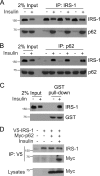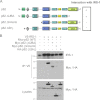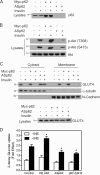Sequestosome 1/p62, a scaffolding protein, is a newly identified partner of IRS-1 protein
- PMID: 22761437
- PMCID: PMC3436154
- DOI: 10.1074/jbc.M111.322404
Sequestosome 1/p62, a scaffolding protein, is a newly identified partner of IRS-1 protein
Abstract
Defects in the insulin-signaling pathway may lead to the development of skeletal muscle insulin resistance, which is one of the earliest abnormalities detected in individuals with the metabolic syndrome and predisposes them to develop type 2 diabetes. Previous studies have shown that deletion of the mouse sequestosome 1/p62 gene results in mature-onset obesity that progresses to insulin and leptin resistance and, ultimately, type 2 diabetes. Sequestosome 1/p62 is involved in receptor-mediated signal transduction and functions as an intracellular signal modulator or adaptor protein. Insulin receptor substrate-1 (IRS-1) plays a central role in transducing the insulin signal via phosphorylation, protein-protein interactions, and protein modifications. Mapping studies demonstrated that the SH(2) domain at the amino terminus of sequestosome 1/p62 interacts with IRS-1 upon insulin stimulation. Further, IRS-1 interacts with p62 through its YMXM motifs at Tyr-608, Tyr-628, and/or Tyr-658 in a manner similar to its interaction with p85 of phosphoinositol 3-kinase. Overexpression of p62 increased phosphorylation of Akt, GLUT4 translocation, and glucose uptake, providing evidence that p62 participates in the insulin-signaling pathway through its interactions with IRS-1.
Figures





Similar articles
-
Protein Scaffolds Control Localized Protein Kinase Cζ Activity.J Biol Chem. 2016 Jun 24;291(26):13809-22. doi: 10.1074/jbc.M116.729483. Epub 2016 May 3. J Biol Chem. 2016. PMID: 27143478 Free PMC article.
-
53BP2S, interacting with insulin receptor substrates, modulates insulin signaling.J Biol Chem. 2007 Dec 28;282(52):37747-58. doi: 10.1074/jbc.M702472200. Epub 2007 Oct 26. J Biol Chem. 2007. PMID: 17965023
-
Morphine induces desensitization of insulin receptor signaling.Mol Cell Biol. 2003 Sep;23(17):6255-66. doi: 10.1128/MCB.23.17.6255-6266.2003. Mol Cell Biol. 2003. PMID: 12917346 Free PMC article.
-
IRS proteins and diabetic complications.Diabetologia. 2016 Nov;59(11):2280-2291. doi: 10.1007/s00125-016-4072-7. Epub 2016 Aug 11. Diabetologia. 2016. PMID: 27514532 Free PMC article. Review.
-
The emerging potential role of p62 in cancer treatment by regulating metabolism.Trends Endocrinol Metab. 2023 Aug;34(8):474-488. doi: 10.1016/j.tem.2023.05.004. Epub 2023 Jun 20. Trends Endocrinol Metab. 2023. PMID: 37349161 Review.
Cited by
-
Role of p62/SQSTM1 in liver physiology and pathogenesis.Exp Biol Med (Maywood). 2013 May;238(5):525-38. doi: 10.1177/1535370213489446. Exp Biol Med (Maywood). 2013. PMID: 23856904 Free PMC article. Review.
-
Absence of IQGAP1 Protein Leads to Insulin Resistance.J Biol Chem. 2017 Feb 24;292(8):3273-3289. doi: 10.1074/jbc.M116.752642. Epub 2017 Jan 12. J Biol Chem. 2017. PMID: 28082684 Free PMC article.
-
Protein Scaffolds Control Localized Protein Kinase Cζ Activity.J Biol Chem. 2016 Jun 24;291(26):13809-22. doi: 10.1074/jbc.M116.729483. Epub 2016 May 3. J Biol Chem. 2016. PMID: 27143478 Free PMC article.
-
Apoptosis, autophagy & endoplasmic reticulum stress in diabetes mellitus.Indian J Med Res. 2016 Oct;144(4):515-524. doi: 10.4103/0971-5916.200887. Indian J Med Res. 2016. PMID: 28256459 Free PMC article. Review.
-
Nerve growth factor receptor TrkA, a new receptor in insulin signaling pathway in PC12 cells.J Biol Chem. 2013 Aug 16;288(33):23807-13. doi: 10.1074/jbc.M112.436279. Epub 2013 Jun 7. J Biol Chem. 2013. PMID: 23749991 Free PMC article.
References
-
- Bouzakri K., Koistinen H. A., Zierath J. R. (2005) Molecular mechanisms of skeletal muscle insulin resistance in type 2 diabetes. Curr. Diabetes Rev. 1, 167–174 - PubMed
-
- Lee J., Pilch P. F., Shoelson S. E., Scarlata S. F. (1997) Conformational changes of the insulin receptor upon insulin binding and activation as monitored by fluorescence spectroscopy. Biochemistry 36, 2701–2708 - PubMed
-
- Myers M. G., Jr., Grammer T. C., Brooks J., Glasheen E. M., Wang L. M., Sun X. J., Blenis J., Pierce J. H., White M. F. (1995) The pleckstrin homology domain in insulin receptor substrate-1 sensitizes insulin signaling. J. Biol. Chem. 270, 11715–11718 - PubMed
-
- Myers M. G., Jr., White M. F. (1996) Insulin signal transduction and the IRS proteins. Annu. Rev. Pharmacol. Toxicol. 36, 615–658 - PubMed
-
- Craparo A., O'Neill T. J., Gustafson T. A. (1995) Non-SH2 domains within insulin receptor substrate-1 and SHC mediate their phosphotyrosine-dependent interaction with the NPEY motif of the insulin-like growth factor I receptor. J. Biol. Chem. 270, 15639–15643 - PubMed
Publication types
MeSH terms
Substances
LinkOut - more resources
Full Text Sources
Medical

